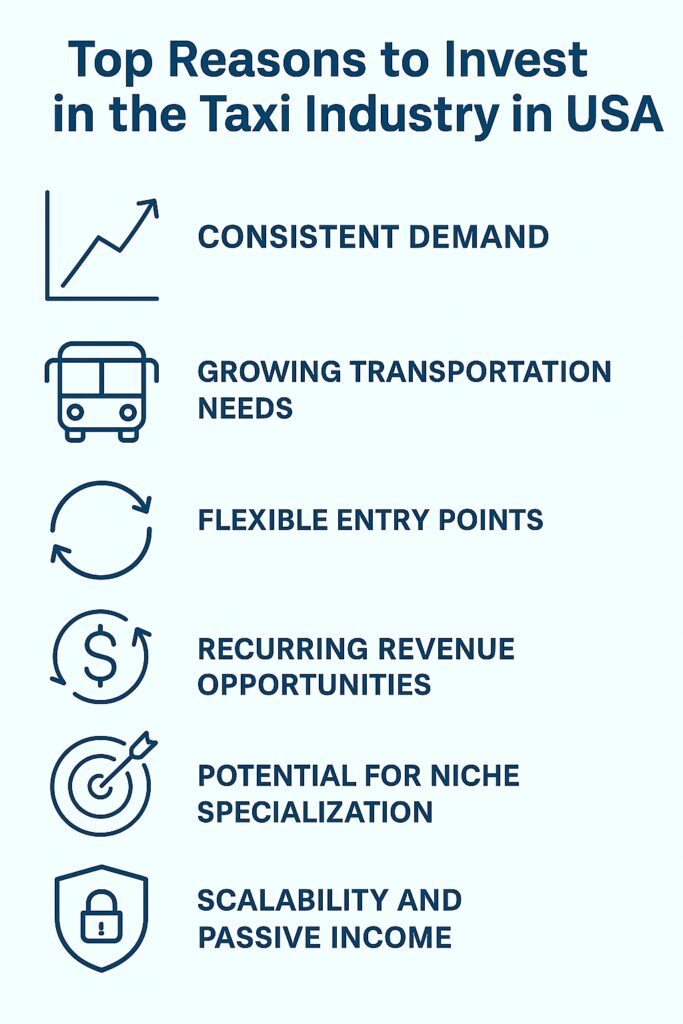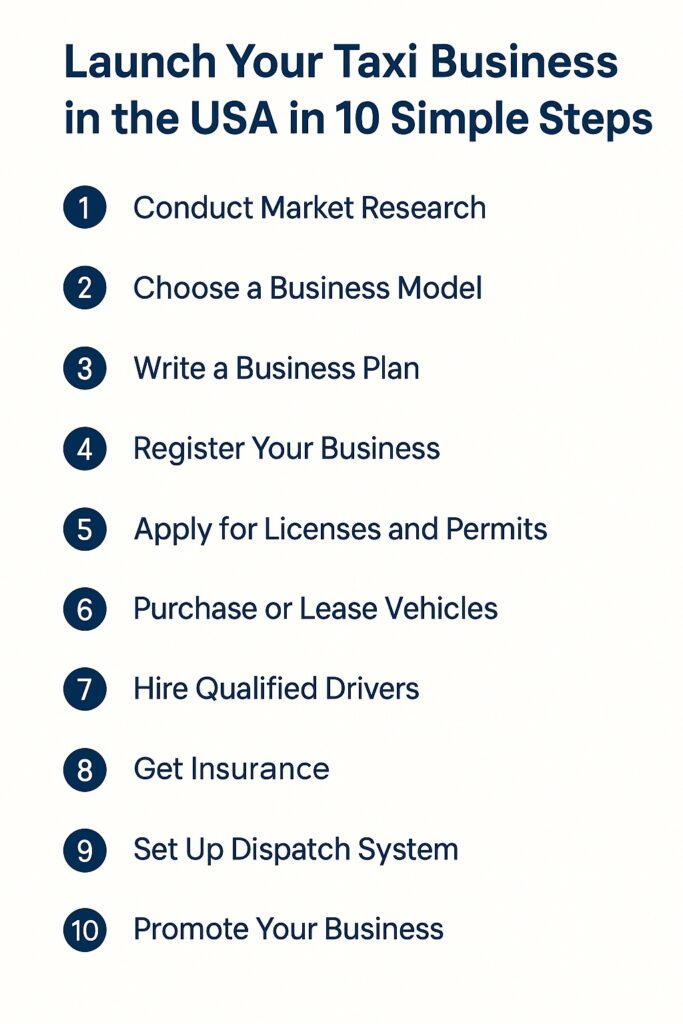Starting a taxi business in USA can be both rewarding and lucrative when approached with the right planning and legal awareness. With the rise of rideshare platforms like Uber and Lyft, the traditional taxi industry has seen changes but still retains strong market demand—especially in urban centers, tourist destinations, and underserved suburban and rural areas. Whether you’re eyeing a conventional taxi fleet or a hybrid operation combining traditional cabs with ride-hailing app integration, the opportunity exists for entrepreneurs willing to navigate the landscape.
This guide offers a comprehensive breakdown of what it takes to start a taxi business in USA—from understanding the current industry climate and choosing the right business model to navigating legal requirements, estimating startup costs, and evaluating long-term profitability. If you’re ready to take the driver’s seat in this competitive yet stable industry, keep reading for a step-by-step plan tailored to succeed in the U.S. market.
Understanding the Taxi Industry Landscape
The taxi industry in the United States has evolved dramatically over the past decade. Once dominated by yellow cabs and metered rides, the industry has experienced a shake-up due to the rise of app-based ride-hailing services. Despite this disruption, traditional taxi services still play a crucial role—especially in cities with regulated cab systems like New York, Chicago, and San Francisco.
Taxi services are vital for seniors, tourists, and passengers who prefer scheduled or cash-based rides over app-driven alternatives. In smaller towns and suburban areas, where ride-hailing availability may be limited, traditional taxi services continue to flourish.
The market also sees diversification through niche offerings like airport transportation, medical transport, corporate contracts, and environmentally conscious “green” taxis. As cities work to regulate rideshare platforms more strictly, the playing field is becoming more balanced, offering a window of opportunity for new players in the taxi space.
Understanding these dynamics will help you identify your niche and develop a taxi business model that aligns with both local demand and evolving consumer expectations.
Decide Your Business Model for Taxi Business in USA
Before launching your taxi business in USA, you must choose the right business model based on your goals, resources, and target market. Here are the most common options:
- Owner-Operator: In this model, you own and drive your taxi. It’s ideal for small-scale entrepreneurs who want full control and lower startup costs.
- Fleet Owner: This model involves owning multiple taxis and hiring drivers to operate them. It requires more capital but allows for greater revenue potential and business scaling.
- Leasing Model: You purchase vehicles and lease them to licensed drivers. This reduces your operational responsibilities but demands careful vetting and contract management.
- Hybrid Model: A combination of the above, where you may drive occasionally while also managing a fleet or leasing part of it.
- Taxi + App Integration: Consider offering your services via a custom app or by partnering with third-party platforms. This helps you stay competitive in the digital age.
Choosing the right model depends on factors like your budget, desired involvement level, and growth strategy. It’s crucial to align your model with local market conditions and regulatory limitations.
Key Reasons to Invest in Taxi Business in USA

Investing in a taxi business in USA presents numerous advantages, especially for entrepreneurs seeking a stable and scalable venture. Here are key reasons why this industry remains a solid investment:
Consistent Demand
Despite the emergence of rideshare apps, there remains a steady demand for traditional taxi services, particularly in cities with strict regulations or where certain customer groups prefer taxis—such as seniors, tourists, and those without smartphones.
Growing Transportation Needs
As urban populations grow and public transportation networks become overwhelmed, taxis provide a reliable alternative for short- and medium-distance commutes.
Flexible Entry Points
The business allows for flexible entry—from a single vehicle owner-operator setup to a full-fledged fleet. This adaptability makes it accessible to investors with varied budgets.
Recurring Revenue Opportunities
Taxis often receive repeat business from airports, hospitals, hotels, and corporate clients. Establishing contracts with such institutions can create reliable income streams.
Potential for Niche Specialization
There’s room to specialize in airport transfers, medical transport, luxury services, or eco-friendly taxis—each with its distinct customer base and pricing power.
Scalability and Passive Income
Fleet owners can generate passive income by hiring or leasing vehicles to drivers. With effective management, the business can grow beyond a single location.
Regulatory Barriers Can Be a Moat
In cities that require medallions or permits, entry barriers can reduce competition once you’re established.
With careful planning, adherence to regulations, and a focus on customer service, the taxi industry in the USA offers a strong return on investment for motivated entrepreneurs.
What Are the Legal Requirements for a Taxi Business in USA?
Operating a taxi business in USA requires compliance with various federal, state, and local regulations. These rules ensure safety, fair pricing, and consumer protection. Below are the main legal steps to consider:
- Business Registration: First, register your taxi business as a legal entity—such as an LLC, sole proprietorship, or corporation. An LLC is often ideal for liability protection and tax flexibility.
- Commercial Driver’s License (CDL): Although not always required, some states mandate a CDL for taxi drivers. At minimum, drivers must have a valid driver’s license and a clean driving record.
- Taxi or Livery License: You’ll need a special taxi or livery license issued by the city or county where you operate. In cities like New York, this could be a medallion system, while other cities may issue permits.
- Vehicle Inspection and Registration: All taxis must pass regular inspections and be registered as commercial vehicles. Additional equipment like meters, GPS, and cameras may be required.
- Insurance Requirements: Taxi businesses need commercial auto insurance, which covers liability, property damage, medical payments, and uninsured motorists. Some jurisdictions may mandate minimum coverage levels.
- Background Checks: Most municipalities require background checks and drug tests for drivers to ensure passenger safety.
- Local Zoning Laws: Check if your home or business location is zoned for vehicle storage, dispatch operations, or taxi parking.
- Tax Identification Numbers: Obtain an EIN (Employer Identification Number) from the IRS if hiring employees.
Always consult with a local attorney or business consultant to ensure full compliance. Failure to meet legal requirements can result in hefty fines or shutdown orders.
Steps to Start a Taxi Business in USA

Launching a taxi business in USA involves a structured process. Here’s a step-by-step guide to help you get started:
Conduct Market Research
Identify your target market, local competition, and service gaps. Focus on location-specific demands—such as airport services, medical transport, or areas underserved by rideshare apps.
Choose a Business Model
Decide whether you want to be an owner-operator, manage a fleet, or lease out vehicles. Your model will determine your startup costs and management needs.
Write a Business Plan
Include your market analysis, pricing strategy, service offerings, operational costs, and marketing approach. A solid business plan is essential for attracting investors or securing loans.
Register Your Business
Choose a name and register your taxi business as a legal entity in your state. An LLC is a popular choice for its simplicity and liability protection.
Apply for Licenses and Permits
Obtain a taxi license from your city or municipality. This may include medallion purchases, vehicle inspections, and driver certifications. Apply for a federal EIN if hiring staff.
Purchase or Lease Vehicles
Invest in quality, fuel-efficient vehicles. Ensure each is equipped with a taxi meter, GPS, camera (if required), and taxi light. Consider used vehicles to reduce upfront costs.
Hire Qualified Drivers
If not driving yourself, hire professional drivers with clean driving records. Verify background checks and any state-required certifications.
Get Insurance
Buy commercial auto insurance for your fleet. This should include liability, property damage, and personal injury coverage.
Set Up Dispatch System
Whether using a traditional dispatch or app-based system, ensure customers can book your service easily. Consider integrating GPS for route tracking and safety.
Promote Your Business
Use local SEO, flyers, partnerships with hotels or hospitals, and online platforms to attract riders. A strong digital presence can give you an edge over competitors.
By following these steps diligently, you’ll lay a strong foundation for a successful taxi business.
How Profitable is a Taxi Business in USA?
The profitability of a taxi business in USA can vary significantly based on location, business model, operating efficiency, and demand. However, when managed properly, it can be a highly rewarding venture.
Revenue Potential
Taxi businesses typically earn revenue through per-mile rates, base fares, and surcharges. In high-demand urban areas, a single taxi can generate $200–$500 daily, translating to $60,000–$150,000 annually—per vehicle.
Fleet owners multiply this revenue by the number of operating vehicles. Leasing out taxis to drivers can also bring in steady passive income. For example, leasing a taxi for $1000/month to 10 drivers generates $10,000 monthly revenue.
Operating Costs
Common costs include fuel, insurance, maintenance, driver salaries (if applicable), licensing fees, and technology expenses. Fuel-efficient vehicles and optimized routes can significantly reduce costs.
Profit margins usually range between 10–30%, depending on operational efficiency. Owner-operators tend to earn higher personal profits due to lower overhead.
Contracts and Niche Services
Profitability increases with long-term contracts (e.g., with hotels, airports, hospitals, or schools). Offering niche services—such as medical transport—can allow for premium pricing and government reimbursements.
Technology Integration
Businesses that leverage technology for dispatching, customer booking, and payment often see higher customer satisfaction and lower costs, boosting profit margins.
Seasonal and Location Factors
Tourist seasons, city events, and weather can temporarily spike profits. Conversely, rural areas may have slower business but lower competition and expenses.
In conclusion, while the taxi business isn’t a get-rich-quick scheme, it offers consistent income, scalable opportunities, and room for innovation. With proper planning and cost control, profits can grow steadily over time.
How Much Does It Cost to Start a Taxi Business in USA?
The startup cost for a taxi business in USA depends on your chosen model and location. Here’s a general breakdown:
- Vehicle Purchase: A new taxi vehicle may cost $25,000–$40,000, while used ones can go for $8,000–$20,000.
- Licensing and Permits: Fees vary by city. In NYC, medallions can cost thousands, while in other cities, permits may be just a few hundred dollars.
- Insurance: Commercial auto insurance typically ranges from $3,000 to $10,000 per vehicle annually.
- Branding and Equipment: Meters, decals, cameras, and GPS systems cost about $1,000–$2,500 per vehicle.
- Legal and Administrative Costs: Business registration, EIN, legal consultation, and compliance paperwork may add another $500–$2,000.
- Marketing and Dispatch System: Budget $1,000–$5,000 to establish a website, digital ads, and booking platform.
So, starting as an owner-operator might cost $10,000–$30,000. A fleet-based model may require $50,000–$200,000 or more depending on scale.
Starting small, with one or two cars, helps manage costs while you build experience and brand recognition.
Why Choose Synarion IT Solutions as Your Taxi Booking App Development Company in USA?
Synarion IT Solutions offers cutting-edge taxi booking app development tailored for the U.S. market. With a proven track record, robust technology stack, and deep industry insight, they deliver scalable, secure, and user-friendly applications. From real-time tracking to seamless payments, Synarion ensures optimal performance and customer satisfaction—making them the ideal partner to bring your taxi business vision to life.
Final Words
Starting a taxi business in USA is both a traditional and forward-looking opportunity. The industry, though challenged by rideshare apps, still holds strong appeal for entrepreneurs who prioritize service, reliability, and compliance. By understanding the modern taxi landscape, choosing the right business model, and meeting legal obligations, you lay the foundation for a sustainable venture.
A successful taxi business is built on more than just vehicles—it requires strategic marketing, reliable service, skilled drivers, and strong customer relationships. Whether you start solo or build a fleet, focus on long-term reputation and operational efficiency.
From urban hotspots to suburban communities, demand for quality transportation remains constant. By innovating, leveraging technology, and carving out a niche, you can thrive even in competitive markets.
If you’re prepared to invest time, capital, and effort, the taxi business can offer you not only consistent income but the independence of entrepreneurship. As the industry continues to evolve, those who adapt and serve their communities with excellence will find enduring success.
Useful Resource: Taxi Booking App Development Guide






What do you think?
It is nice to know your opinion. Leave a comment.